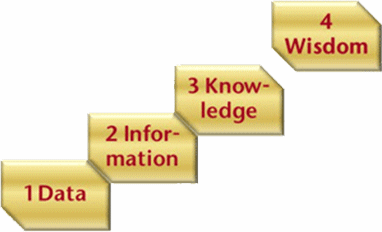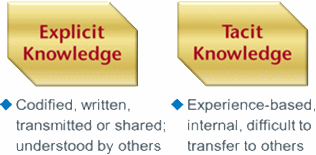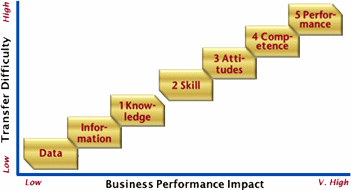|
Last month I talked about talent acquisition. Now the
question is: Can people develop talent in others? My answer is: Yes, as long as
your people already fulfill some of those innate aspects of Talent I mentioned
earlier. Talent alone is not enough; Charles Koch, the billionaire investor, says
that Values are even more important than Talent — he judges Values higher
than Talent in job seekers. So yes, given the right potential, you can develop
talent. Whose job is this? I believe that the answer depends on each situation,
but it is usually some combination of Resource Managers, Project Managers, and
Human Resources Managers.
Our First Insights into the Stairway to Talent
 In
the late 1970s, I sought to improve decision-making through use of management
information. I applied a concept from an article I had read. I introduced the
Taxonomy of Data, shown at the right. I presented it to managers, to associations,
and other audiences, in the late 1970s. I had one problem: Note the gap between
Knowledge and Wisdom (in that era, our ultimate objective). I post a bit more
about this Taxonomy of Data in my blog: projectexperts.com/does-knowledge-want-to-be-managed/.
The context is a Knowledge Management article, with recent references to the topic
by the legendary Max Wideman. In
the late 1970s, I sought to improve decision-making through use of management
information. I applied a concept from an article I had read. I introduced the
Taxonomy of Data, shown at the right. I presented it to managers, to associations,
and other audiences, in the late 1970s. I had one problem: Note the gap between
Knowledge and Wisdom (in that era, our ultimate objective). I post a bit more
about this Taxonomy of Data in my blog: projectexperts.com/does-knowledge-want-to-be-managed/.
The context is a Knowledge Management article, with recent references to the topic
by the legendary Max Wideman.
 For a dozen years,
I failed to find ways to close that gap between Knowledge and Wisdom. Then, in
the 1990s, when Knowledge Management (KM) emerged, I had an insight. The KM movement
defined two types of knowledge: Explicit and Tacit, as shown in the diagram at
left. I had focused on Explicit Knowledge. Takeuchi and Nonaka, in a great book[5],
showed how transfer of Tacit Knowledge held the secret to closing that gap.
This insight verified everything I knew to be true about learning, especially
for adults. For a dozen years,
I failed to find ways to close that gap between Knowledge and Wisdom. Then, in
the 1990s, when Knowledge Management (KM) emerged, I had an insight. The KM movement
defined two types of knowledge: Explicit and Tacit, as shown in the diagram at
left. I had focused on Explicit Knowledge. Takeuchi and Nonaka, in a great book[5],
showed how transfer of Tacit Knowledge held the secret to closing that gap.
This insight verified everything I knew to be true about learning, especially
for adults.
The Role of Training in Talent Development
Training (or Learning, as I call it) has a clear role in developing talent.
It helps develop the Knowledge foundation to Talent Development, but it does not
instill talent. Why not? Different roles have different learning needs, different
levels of current grasp, and different expectations from their learning. I have
found a proper competence assessment to be the smartest way to assure that improved
business results come from any training. A smart follow-on is to understand the
Learning Objectives (learner outcomes) for each competence, and identify the level
of outcome you require. Bloom's Taxonomy, as revised in 2001[6]
is very useful in this targeting.
The actual training must be well structured to maximize its potential. It must
move beyond "the talking head, pedagogical lecturer," to include learner-centered
in-session and post-session application. For example, in the classroom there must
be exercises, or even better, case studies, scenarios and simulations. Post-class,
there must be on-the-job application, ideally with coaching and guidance,
on real-world problems. Yet, while it is an essential starting point, training
does not deliver Talent. There is another challenge to the knowledge-without-application
trap, that too few people understand: New Knowledge, consistently and properly
applied, moves to Skill. Knowledge that is not applied has a
half-life of two weeks.
Talent Transfer versus Business Impact
 So yes, the right
training can indeed help build the foundation for learning. The challenge, as
shown in the model at right, is moving beyond short-term acquisition of facts and
knowledge; minding the gap, as it were. This is an important thing to understand,
because the greatest benefits come from the application items on the model,
Skill: Attitudes, Competence, and Performance. So yes, the right
training can indeed help build the foundation for learning. The challenge, as
shown in the model at right, is moving beyond short-term acquisition of facts and
knowledge; minding the gap, as it were. This is an important thing to understand,
because the greatest benefits come from the application items on the model,
Skill: Attitudes, Competence, and Performance.
Note that I have added two axes to the model introduced earlier. The vertical
axis, Transfer Difficulty, reflects how hard the Talent level is to transfer.
On the horizontal axis, the items below the gap have very little Business Performance
Impact.
Readers who are involved with Learning will recognize some of the new levels
on the chart. For example, levels 3, 2 and 1 reflect the familiar ASK items.
These are the Attitudes, Skills, and Knowledge, the focus of effective learning.
For those who are familiar with Bloom's Taxonomy (the 2001 version is more
relevant for Adult learners), it builds upon the ASK items, adds measures, and
moves into beginning aspects of Competence, covering levels 1-4 on the chart.
Finally, the model evokes Kirkpatrick's Class Evaluation method, which progresses
from classroom "smile sheets, through on-the-job application, to Performance;
reflecting levels 2-5. The resulting model spans from raw data to business
performance, and provides a roadmap for talent development.
1. IPMA®
is the International Project Management Association, the world's first professional
Project Management association. Learn more about IPMA at www.ipma.world.
2. See our 2006 IPMA China World Congress paper, Distinguishing
PM Competence in Training and Development, in the Articles section of the ProjectExperts.com
website
3. PMI® is a US-based, global professional association for
project managers. Learn more about PMI at www.pmi.org.
4. IIBA® is International Institute of Business Analysis,
"the Voice of the Business Analysis Profession." See them at www.iiba.org.
5. A great book, The Knowledge Creating Company, by Takeuchi
and Nonaka, goes a long ways in helping to understand the leap from explicit to
tacit knowledge, and the methods for transferring between them.
6. Bloom 2001 refers to A Taxonomy for Learning, Teaching and
Assessing, by Lorin W. Anderson & David R. Krathwohl, an intern 45 years
earlier for the original 1956 Bloom's Taxonomy edition. Published by Longman,
2001. All trademarks are the property of their registered owners.
|



